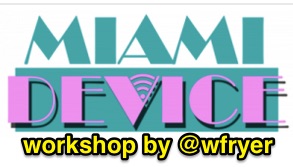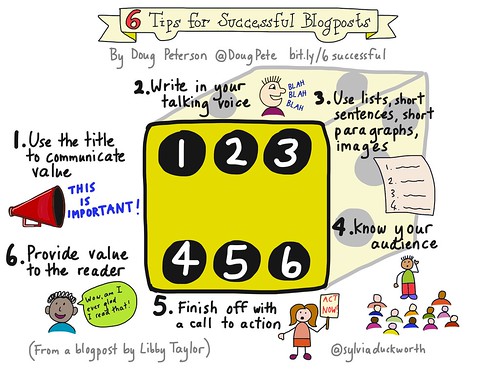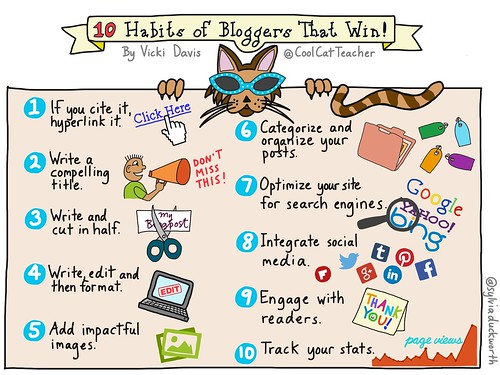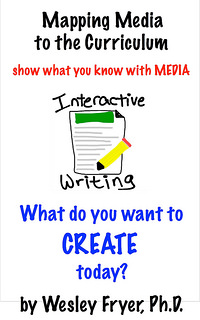 DEFINITION
DEFINITION
Interactive digital writing involves the production and sharing of electronic texts which (in most cases) can be readily:
- Conveyed (transmitted)
- Copied
- Connected (hyperlinked)
- Commented on, and
- Collaboratively constructed
Teachers and students should have and use a moderated, interactive writing spaces. Ideally these spaces should:
- Permit students to submit posts / contribute content independently (not just responding to teacher initiated assignments)
- Give the option to share openly / publicly online (“inside sharing” or “outside sharing” and not require a password to view)
- Permit visitors to submit comments which can be moderated
In addition to blogs, students can interactively write using tools like:
- Seesaw Learning Journals
- Google Docshttps://support.google.com/docs/answer/7068618?co=GENIE.Platform%3DDesktop&hl=en
- Etherpad.
Sylvia Duckworth (@sylviaduckworth) has created several sketchnotes with good tips for student blogging and blogging in general.
This 30 minute narrated slideshow on “Getting Started with Student Blogging” provides an overview of reasons to use a class blog, as well as features of classroom blogging platforms including Blogger, Seesaw, Google Sites and EduBlogs. (from August 13, 2019 – slides are also available)
The post “Blogging with Seesaw” from October 2019 includes several tutorials about how students and teachers can use Seesaw for “outside sharing” of ideas and media projects.
This 50 minute narrated slideshow video, the “Why and How of Outside Sharing with KidBlog,” provides a good overview of both the reasons to use a classroom blog for interactive writing as well as some of the mechanics of getting started. (from February 9, 2016)
Video Examples:
- Benefits of Educational Blogging (14:59) by Kathleen Morris
- How to Use Kidblog.org (9:10) by Lee Kolbert and PalmBreezeCafe
- Teachers and Principals Talk about Google Docs (4:08) by Google
- EtherPad in Education (5:11) by Paul Devoto
WORKFLOW
Initial Setup
- Teacher registers for a free blog account (keeps userid/password secret)
- Email confirmation is often required
- Configure site to allow moderated public comments, import student info or create student accounts
Ongoing Use
- Teacher and students login to the blog and write posts
- Link to blog is shared with others via email, newsletters, school website, Twitter, etc.
- Teacher, students, parents and others submit comments on different posts
- Teacher periodically moderates comments (approves or deletes them)
- Teacher and others use Twitter hashtag #comments4kids to invite public comments
 “Newton’s Laws of Classroom Blogging”
“Newton’s Laws of Classroom Blogging”
TOOLS
The following SIX options for CLASSROOM BLOGGING have been updated in August 2015. Other pricing options are available, pricing shown (as of August 2015) is for a single classroom. Read the post “Classroom Blogging Options (August 2015)” for more details about these options.
| Tool | Free Version | Cost | Can Email Posts? | Supports Google Logins | Audience Options | Site Visibility | Notes |
|---|---|---|---|---|---|---|---|
| Blogger | Y | none unless you register a custom domain | Y | Y | Draft (teacher view only) or Public | Can be member only if students have Google accounts, but best to setup as public | Works great with Easy Blogger & Easy Blogger Jr apps for young (primary/PreK) students. Publishes narrated photos/art videos directly to the teacher's YouTube channel from the app! Also consider EasyBlog.org as a host. (see below) |
| KidBlog | N | $29 per teacher per year * | N | Y | student decides: teacher only, class only, public | Can be class only/private, connections only, or public | KidBlog used to support free sites with up to 25 students, but now users must pay. GREAT website with super feature set for class blogs, well worth $$$. |
| Write About [VIDEO] | Y (but students can just post 5 times each in free version) | $25 per year * | Y (teachers can) | Y | Private, Classmates Only or Public | Classmates only or public, can set permissions by student (including moderation requirements) | Very unique aggregation of community posts by topic/theme in GROUPS. Authentic approach to blogging. Lots of VISUAL prompts provided, teachers can add their own. WriteAbout also supports recorded audio comments by students within posts! Read more background. |
| EduBlogs [VIDEO] | Y (but student/class management features not available in free version) | $40 per year* | Y (via JetPack) | N (requires CampusPress for GAFE support) | not sure | not sure | EduBlogs has an extensive track record supporting teachers and class blogging. Great community support. |
| EasyBlog.org [VIDEO] | Y (limited to first 1000 signups before 1 Sept 2015) | Not announced yet | N | N | not sure | not sure | Works with with Easy Blogger & Easy Blogger Jr apps for young (primary/PreK) students. Publishes narrated art/photo videos and other videos directly to its own hosted platform. Syncs student accounts across shared iPads. |
| WordPress.com | Y | none for basic version | Y (teachers/owners & students/contributors can) | N | Public only | Private (members only) or Public | Can setup student accounts but nearly as user-friendly as other options for this. |
Free Synchronous Collaboration / “Backchannel” Options
- Scrumblr.ca (open source)
- Padlet (formerly called WallWisher)
- Lino (virtual sticky notes)
- EtherPad sites: TitanPad, MeetingWords, RiseUp
- Scrollback
Free Synchronous Collaboration / “Backchannel” Options
- Backchannel Chat (requires student Google logins)
“Walled garden” interactive writing (free but private)
- Edmodo
- MyBigCampus from LightSpeed Systems
- Google Docs can also be used privately
Interactive Sites Publishing Student Work
iPad Apps
- KidBlog (free)
- Easy Blog Jr. ($5 – WordPress sites)
- Easy Blogger Jr. ($4 – Blogger sites)
- WordPress (free)
EXAMPLES
Stories and Posts
- “6th Grade Parents and Teachers Provide Students Feedback on Writing” (6th grade English blog – Yukon, Oklahoma)
- “The Power of Twitter” (grade 4 student in Victoria, Australia)
- “A Sneak Peek into our Reader’s Workshop!” (1st graders in Ohio – @Frazier1st)
- “Banana Man” – a blog by 5th grader Mason in Yukon, Oklahoma
Class Blogs:
- Eagles Write (elementary classrooms in rural Washington – @grammasheri)
- The KinderKids’ Blog (Deerfield, NH – @MariaK @TheKinderKids)
- Class blog of Jane Ross (grade 4 in Indonesia, click on student names in right sidebar – @janeinjava)
- Class blog of Mrs. Naugle (4th grade outside New Orleans, LA – @plnaugle)
- Class blog of Mr. C (elementary classroom in Kansas City, MO – @wmchamberlain)
- Class blogs in Apache Junction, Arizona
Find More:
More on share.playingwithmedia.com
Tutorials
- How to add an image on Kidblog (3 min video)
- How to Archive a KidBlog Website (3.5 min)
- More Kidblog screencast tutorial videos
- Options for Posting by Email (RIP Posterous)
Fantastic video “How to Write a Quality Comment” by @YollisClass @lindayollis
Writing Prompts
- Write About This ($4 – iOS app)
- Things to Think About (free – iOS app)
- Student Blogging Challenges by @pernilleripp
- Visual Writing Prompts
- Writing Prompts by Luke Neff
Additional Resources
- Tips for Choosing a Classroom Blog (by @wfryer)
- Newton’s Laws of Classroom Blogging (by @wfryer)
- Shop Talk: The Nuts And Bolts Of Student Blogging (by @davidtedu)
- 8 Reasons You Should Have A Professional Blog (by @tombarrett)
Interactive Writing eBook Single ($2.99)
WORKSHOP DESCRIPTION
Interactive Writing: Students and teachers today need to practice interactive digital writing. Learn how to setup, use and moderate content on a classroom website where students can post their work and teachers MODERATE content to improve student writing skills. A moderated classroom blog can be an ideal platform to use to share announcements, classroom news, and student work for a public audience. This can permit parents, grandparents, other students, and other classroom “pen pals” in different places to provide feedback to students and serve as an authentic audience. In this workshop we’ll use the free blogging site KidBlog to model the digital facilitation of student writing. We’ll explore how other websites can also be used by teachers and students create “backchannels” for classroom discussions. We’ll have hands-on practice with tools like TodaysMeet, EtherPad, Google Docs and Google Forms to understand ways these tools can be used to amplify student voices, empower student creative expression and fluency with text. The importance and value of MODERATING student posts shared to public websites will be emphasized, as well as options teachers have to amplify student work using PLNs (professional learning communities) with projects like #comments4kids. Teachers will leave this workshop inspired with new ideas to energize their writing classes with students using safe, moderated approaches to digital, interactive writing.
* Image attribution: Fasticon via iconfinder.com






 Twitter
Twitter GooglePlus
GooglePlus Youtube
Youtube RSS
RSS Facebook
Facebook LinkedIn
LinkedIn Flickr
Flickr SlideShare
SlideShare
1 comment
17 pings
Skip to comment form
I love this idea! I will talk to the teachers anf find the way to start it with the higher forms.
[…] Share Their Digital Journeys The digital journey that i decided to look further into was called Interactive Writing. The reason that I chose to explore more about writing is because I usually lacked interest in […]
[…] Interactive Writing is one project that seems to be new to the teaching world. Every classroom teacher creates an interactive class blog where the students can respond and submit posts to the blog in response to the teacher’s posts. This would be a useful project for teachers, because it would involve the students with classroom activities outside of school, while also providing parents with access to what is going on in class every day. […]
[…] For my second response to Iowa Teachers Share Their Digital Journey, I went with an article about Interactive Writing. The thought of interactive writing is that it is an option for students to write on your blog. […]
[…] with an emphasis on a classroom blog. I think this is part of Wesley Fryer’s doings, and the site can be found here. He states that an interactive class blog should “permit students to post to the blog, be […]
[…] with 6 Iowa teachers about how to”Map Media into the cirrculum”. I really liked the Interactive Writing note that was added. It gives the tools and ideas about incorporating a blog in the classroom as […]
[…] Via BLOGS and other tools real-class examples easy to use link […]
[…] and digital learning initiative. Instead of saying “blog” I’m focusing on “interactive writing.” Instead of “podcast” I’m encouraging student digital projects using […]
[…] Getting Started with Interactive Digital Writing […]
[…] enjoy afterwards! For more resources related to interactive writing and student blogging, check out the “Interactive Writing” page of “Mapping Media to the Common […]
[…] you’re a PK-20 educator today, I strongly encourage you to utilize a PUBLIC platform for “interactive writing” with your students. Hopefully we’ll see more options in the weeks and months ahead for “posting by […]
[…] I was first alerted to this thanks to a discussion in the ePUB ebook chapter I wrote (on “Interactive Writing“) and we’re reading as well as discussing together in the free iPad app, […]
[…] wonder what support for interactive writing / blogging should look like at the high school / secondary level? Here’s a fantastic answer to that […]
[…] which include hyperlinks, images and embedded videos. Then your students can engage in “interactive writing” on your class blog (which serves as their “digital portfolio,”) can create […]
[…] which include hyperlinks, images and embedded videos. Then your students can engage in “interactive writing” on your class blog (which serves as their “digital portfolio,”) can create […]
[…] Learned more about interactive writing […]
[…] Interactive Writing: I’m a huge advocate for digital interactive writing for students. Both last year and this year, I created free KidBlog websites for each of the classes […]
[…] August 2015. These options are highlighted further in the hyperlinked table I’ve updated on the “Interactive Writing” page of ShowWithMedia.com. The platforms I’ll review include Blogger.com, KidBlog.org, WriteAbout.com, EduBlogs.org, […]